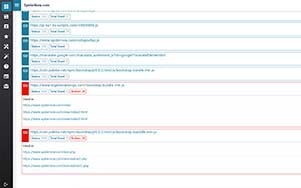What are web accessibility guidelines?
Web accessibility guidelines are a set of standards and recommendations designed to ensure that websites and web content are accessible to people with disabilities. These guidelines provide best practices and technical specifications for creating websites that are usable and navigable for individuals with various disabilities, including visual, auditory, motor, and cognitive impairments.
Why are web accessibility guidelines important?
Web Accessibility Guidelines: Web accessibility guidelines are a set of standards and best practices designed to ensure that websites and web applications are accessible to people with disabilities. These guidelines cover various aspects of web design, development, and content creation to ensure that websites are usable by all individuals, regardless of their abilities.
Importance: Web accessibility guidelines are essential for promoting inclusivity and ensuring equal access to information and services online. By following these guidelines, website owners can accommodate users with disabilities and provide a better user experience for all visitors. Additionally, adhering to accessibility standards can help websites avoid legal issues related to accessibility compliance.
The importance of web accessibility standards goes beyond compliance with legal requirements. By making websites accessible, businesses and organizations can reach a larger audience and tap into the potential of an untapped market. Moreover, accessible websites provide a better user experience for all users, including those without disabilities. Easy navigation, clear content, and optimized functionality benefit everyone who visits a website.
Key Principles of Web Accessibility
Web accessibility is guided by several key principles that aim to make websites universally accessible. These principles include perceivability, operability, understandability, and robustness.
Perceivability ensures that all users can perceive the information and content on a website, regardless of their sensory abilities. This includes providing alternative text for images, captions for videos, and clear headings for easy navigation.
Operability focuses on making websites functional for all users. This involves providing keyboard navigation options, ensuring that interactive elements are accessible without a mouse, and avoiding seizure-inducing design elements.
Understandability involves making the content and functionality of a website clear and easy to comprehend. This includes using plain language, organizing information in a logical manner, and providing instructions and error messages that are easy to understand.
Robustness refers to the ability of a website to adapt and function across different devices and assistive technologies. Websites should be built using standard coding practices and adhere to web accessibility standards to ensure compatibility with various browsers and assistive technologies.
Benefits of Meeting Accessibility Guidelines
Meeting web accessibility guidelines offers numerous benefits for both website owners and users. Some of the key benefits include:
1. Increased Reach: By ensuring accessibility, websites can reach a wider audience, including individuals with disabilities. This can lead to increased traffic, engagement, and potential customers.
2. Legal Compliance: Many countries have laws and regulations in place that require websites to be accessible to individuals with disabilities. By meeting accessibility guidelines, website owners can avoid legal issues and potential penalties.
3. Enhanced User Experience: Accessible websites provide a better user experience for all users. Clear navigation, readable content, and optimized functionality make it easier for users to find information, complete tasks, and interact with the website.
4. Improved SEO: Implementing accessibility features, such as alternative text for images and proper heading structure, can improve a website's search engine optimization (SEO) by making it more understandable and navigable for search engines.
5. Positive Brand Image: By prioritizing accessibility, businesses and organizations demonstrate their commitment to inclusivity and equal access. This can enhance their brand image and reputation among customers and stakeholders.
Tools and Resources for Web Accessibility
There are various tools and resources available to help website owners and developers ensure web accessibility. Some of these include:
1. Screen Readers: Screen readers are software programs that read out the content of a website for individuals with visual impairments. Examples of popular screen readers include JAWS, NVDA, and VoiceOver.
2. Color Contrast Checkers: Color contrast checkers help ensure that text and visual elements on a website have sufficient contrast for individuals with visual impairments. Tools like WebAIM's Color Contrast Checker can assist in evaluating color combinations.
3. Accessibility Testing Tools: Accessibility testing tools, such as WAVE and Axe, can scan websites for accessibility issues and provide recommendations for improvement.
4. Web Accessibility Guidelines: The Web Content Accessibility Guidelines (WCAG) provide detailed guidelines and success criteria for making websites accessible. These guidelines serve as a valuable resource for understanding and implementing web accessibility.
By utilizing these tools and resources, website owners and developers can enhance the accessibility of their websites and ensure a more inclusive online experience for all users.










